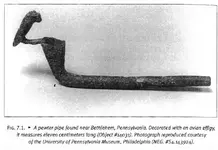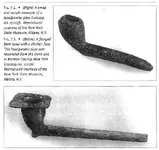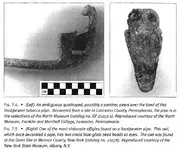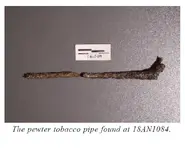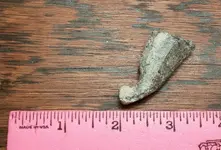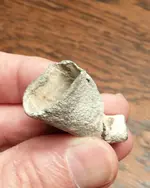Silver Tree Chaser
Bronze Member
A recent search of the woods has me reconsidering my preference for searching open fields. I had been scouting for a potential cellar hole but only located the ruins of a barn. Over an hour of searching produced two plain buttons and a more satisfying recovery, an ornate horse bridle rosette of pewter and brass (possibly dating early to mid-1800s). Here’s the rosette.
![DSCN0696[1].webp DSCN0696[1].webp](https://www.treasurenet.com/data/attachments/1308/1308092-e4a6bd64d12b8d600bd8ff0da42653d8.jpg?hash=Bqqy4aYaBJ)
I widened my search area to hopefully locate the house foundation but only came upon another barn site with old trash scattered about the brush. Retreating back to the first barn, I came upon a loud, high-toned signal near the opening of a stone wall. I figured that the target was a shotgun shell, rusted can, or other form of modern trash – I couldn’t have been more wrong. After removing a large cut plug, and loosened up some dirt, I fished around with my probe and uncovered a small, intact tobacco pipe that appeared to date from long ago. Digging into cellar holes and trash pits over the years, I've found a few nearly intact pipes – but never complete and certainly never so old.
![DSCN0574[1].webp DSCN0574[1].webp](https://www.treasurenet.com/data/attachments/1308/1308104-97c48006f1854410880045e09489496f.jpg?hash=iibdw26v0p)
![DSCN0568[1].webp DSCN0568[1].webp](https://www.treasurenet.com/data/attachments/1308/1308106-4448cde73ff95bfc2d640f6ee22fb44d.jpg?hash=VX4mP4oWma)
Such a surprising find triggers a number of thoughts in an instant: “How could it be complete? What are the odds of digging a pipe by chance? Pipes are clay – so what else was in the hole?” I picked up the pipe and was astonished by its heavy weight and solid feel! It was a metal pipe of lead or pewter! I was just ending my morning hunt, so I took some pictures and a short video. I searched for other associated finds in the immediate area and headed home eager to research my unique find.
I picked up the pipe and was astonished by its heavy weight and solid feel! It was a metal pipe of lead or pewter! I was just ending my morning hunt, so I took some pictures and a short video. I searched for other associated finds in the immediate area and headed home eager to research my unique find.
I figured the pipe was Native American in origin, and a search online confirmed this beyond all doubt. The pipe was found along an old Indian trail in Rhode Island. The colony was founded by Roger Williams, the wayward minister who fled from the authorities in the Massachusetts Bay Colony in 1636 to avoid being shipped back to England. He spent the winter with a neighboring tribe, eventually settled, and traded with the powerful Narragansetts to the south of his settlement in Providence. His knowledge of the local tribes and their language resulted in his authoring a book published way back in 1643 - A Key into the Language of America. It was the very first study of a Native American language written in English; it’s this book that also confirmed that my recovered pipe was Native American in origin! In his book written in old English, Williams describes the metal working abilities of his native neighbors with the following: “They have an excellent art to cast our pewter and brasse into very neate and artificiall pipes.” I had found a specimen of one of these exact pipes!
![Key_Into_the_Language_of_America[1].webp Key_Into_the_Language_of_America[1].webp](https://www.treasurenet.com/data/attachments/1308/1308111-37c1fabbc087be60f1b87d350e2601f5.jpg?hash=N26H3hOv3b)
I’ve dug my share of pewter over the years, all of it reduced to bits and pieces, usually a spoon handle or a button, but somehow this pipe emerged from the soil nor worse for the course of 340+ years buried in the ground.
![DSCN0625[1].webp DSCN0625[1].webp](https://www.treasurenet.com/data/attachments/1308/1308098-ce4f83174dd8d60cea925a7ae767afe1.jpg?hash=jC0JscNVFG)
I took the precaution of having the pipe checked out by a professional conservator who was very helpful and offered sound advice. I allowed the pipe to slowly dry as the conservator instructed, and it remains completely stable and solid. I still need to lightly brush off some of the surface dirt, but I’m going to leave the dirt in the bowl untouched. I’m making arrangements to have the artifact properly stored with inert material to minimize the chance of any future deterioration. Here's the pipe after thoroughly drying.
![DSCN0685[1].webp DSCN0685[1].webp](https://www.treasurenet.com/data/attachments/1308/1308084-cb76aecb2025c85fe29a618ffb0db3f4.jpg?hash=tz_r9Q48hb)
The pipe dates as early as the 1630s and no later than 1676. The pipe most likely belonged to a Narragansett brave. So how rare are Native American pewter pipes? They are very rare. “Neat and Artificial”: Base Metal Trade Pipes of the Northeastern Indians is the title of a 2004 study of pewter pipes that I found online. This study could only account for a total of 43 pewter pipes in the holding of several museums. They are as follows.
![DSCN0699[1].webp DSCN0699[1].webp](https://www.treasurenet.com/data/attachments/1308/1308096-8bafcd342e8e9385fde719ff61025bc3.jpg?hash=bQ7oTwznLj)
The study estimated that no more than 150 pewter pipes exist overall between museums and private collections. Nearly all of the 43 pipes from the study were recovered in the excavation of burial sites, as the pipes were deposited as grave goods. How it was that I came upon an apparent dropped pipe certainly seems highly implausible, but is it really so? This is one of my very best historical finds dating between the arrival of the English in New England and the inevitable conflict between the English and most of the Algonquin tribes of New England It was called King Phillip’s War, after the sachem of the Wampanoags, and the conflict all but consumed New England from 1675-1676. Interestingly, major fighting took place in the area where I recovered the pipe; moreover, colonial forces captured a large number of Narragansetts at nearby campsites. They were eventually sold into slavery in the West Indies. Perhaps these events are connected to the loss of pipe? It’s possible, but what’s certain is the overall identity of the pipe – dating to the mid-1600’s, fashioned from English pewter, Native American in origin, and fashioned by hand, as described by Rhode Island’s founder, Roger Williams.
I only recovered a single musket ball on a return trip to the site, but I’ll be going back sooner or later. My apologies for the long post, but the significance of some finds, if not many finds, is all in the details.
Good Hunting!
![DSCN0696[1].webp DSCN0696[1].webp](https://www.treasurenet.com/data/attachments/1308/1308092-e4a6bd64d12b8d600bd8ff0da42653d8.jpg?hash=Bqqy4aYaBJ)
I widened my search area to hopefully locate the house foundation but only came upon another barn site with old trash scattered about the brush. Retreating back to the first barn, I came upon a loud, high-toned signal near the opening of a stone wall. I figured that the target was a shotgun shell, rusted can, or other form of modern trash – I couldn’t have been more wrong. After removing a large cut plug, and loosened up some dirt, I fished around with my probe and uncovered a small, intact tobacco pipe that appeared to date from long ago. Digging into cellar holes and trash pits over the years, I've found a few nearly intact pipes – but never complete and certainly never so old.

![DSCN0574[1].webp DSCN0574[1].webp](https://www.treasurenet.com/data/attachments/1308/1308104-97c48006f1854410880045e09489496f.jpg?hash=iibdw26v0p)
![DSCN0568[1].webp DSCN0568[1].webp](https://www.treasurenet.com/data/attachments/1308/1308106-4448cde73ff95bfc2d640f6ee22fb44d.jpg?hash=VX4mP4oWma)
Such a surprising find triggers a number of thoughts in an instant: “How could it be complete? What are the odds of digging a pipe by chance? Pipes are clay – so what else was in the hole?”
I figured the pipe was Native American in origin, and a search online confirmed this beyond all doubt. The pipe was found along an old Indian trail in Rhode Island. The colony was founded by Roger Williams, the wayward minister who fled from the authorities in the Massachusetts Bay Colony in 1636 to avoid being shipped back to England. He spent the winter with a neighboring tribe, eventually settled, and traded with the powerful Narragansetts to the south of his settlement in Providence. His knowledge of the local tribes and their language resulted in his authoring a book published way back in 1643 - A Key into the Language of America. It was the very first study of a Native American language written in English; it’s this book that also confirmed that my recovered pipe was Native American in origin! In his book written in old English, Williams describes the metal working abilities of his native neighbors with the following: “They have an excellent art to cast our pewter and brasse into very neate and artificiall pipes.” I had found a specimen of one of these exact pipes!
![Key_Into_the_Language_of_America[1].webp Key_Into_the_Language_of_America[1].webp](https://www.treasurenet.com/data/attachments/1308/1308111-37c1fabbc087be60f1b87d350e2601f5.jpg?hash=N26H3hOv3b)
I’ve dug my share of pewter over the years, all of it reduced to bits and pieces, usually a spoon handle or a button, but somehow this pipe emerged from the soil nor worse for the course of 340+ years buried in the ground.
![DSCN0625[1].webp DSCN0625[1].webp](https://www.treasurenet.com/data/attachments/1308/1308098-ce4f83174dd8d60cea925a7ae767afe1.jpg?hash=jC0JscNVFG)
I took the precaution of having the pipe checked out by a professional conservator who was very helpful and offered sound advice. I allowed the pipe to slowly dry as the conservator instructed, and it remains completely stable and solid. I still need to lightly brush off some of the surface dirt, but I’m going to leave the dirt in the bowl untouched. I’m making arrangements to have the artifact properly stored with inert material to minimize the chance of any future deterioration. Here's the pipe after thoroughly drying.
![DSCN0685[1].webp DSCN0685[1].webp](https://www.treasurenet.com/data/attachments/1308/1308084-cb76aecb2025c85fe29a618ffb0db3f4.jpg?hash=tz_r9Q48hb)
The pipe dates as early as the 1630s and no later than 1676. The pipe most likely belonged to a Narragansett brave. So how rare are Native American pewter pipes? They are very rare. “Neat and Artificial”: Base Metal Trade Pipes of the Northeastern Indians is the title of a 2004 study of pewter pipes that I found online. This study could only account for a total of 43 pewter pipes in the holding of several museums. They are as follows.
![DSCN0699[1].webp DSCN0699[1].webp](https://www.treasurenet.com/data/attachments/1308/1308096-8bafcd342e8e9385fde719ff61025bc3.jpg?hash=bQ7oTwznLj)
The study estimated that no more than 150 pewter pipes exist overall between museums and private collections. Nearly all of the 43 pipes from the study were recovered in the excavation of burial sites, as the pipes were deposited as grave goods. How it was that I came upon an apparent dropped pipe certainly seems highly implausible, but is it really so? This is one of my very best historical finds dating between the arrival of the English in New England and the inevitable conflict between the English and most of the Algonquin tribes of New England It was called King Phillip’s War, after the sachem of the Wampanoags, and the conflict all but consumed New England from 1675-1676. Interestingly, major fighting took place in the area where I recovered the pipe; moreover, colonial forces captured a large number of Narragansetts at nearby campsites. They were eventually sold into slavery in the West Indies. Perhaps these events are connected to the loss of pipe? It’s possible, but what’s certain is the overall identity of the pipe – dating to the mid-1600’s, fashioned from English pewter, Native American in origin, and fashioned by hand, as described by Rhode Island’s founder, Roger Williams.
I only recovered a single musket ball on a return trip to the site, but I’ll be going back sooner or later. My apologies for the long post, but the significance of some finds, if not many finds, is all in the details.
Good Hunting!
Upvote
140

